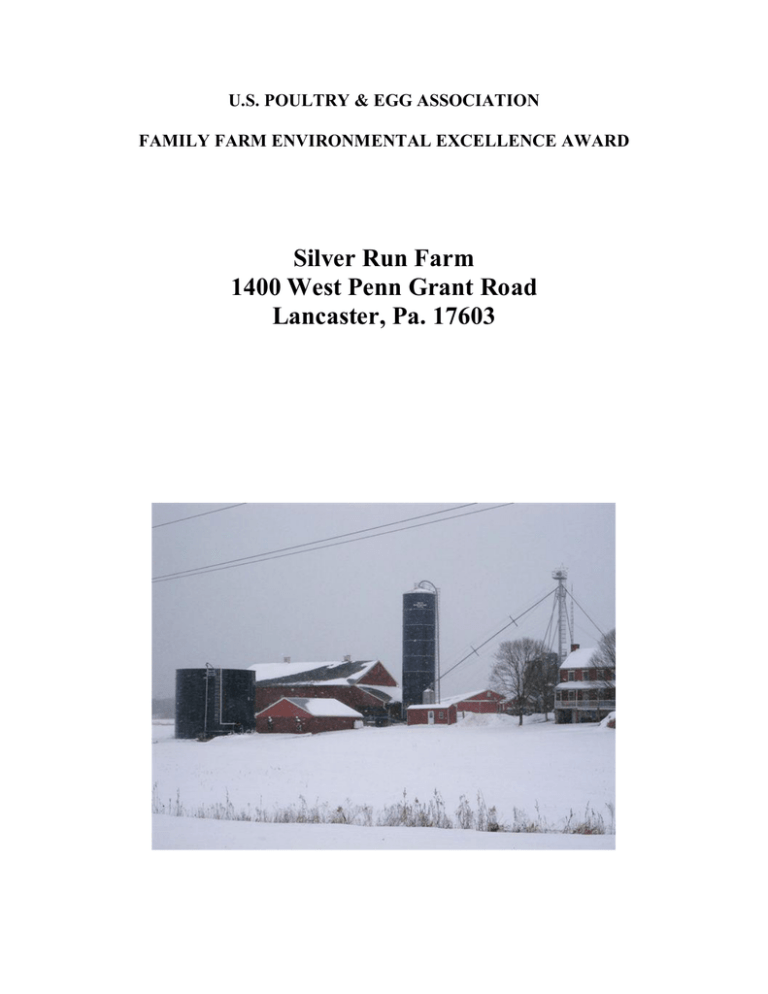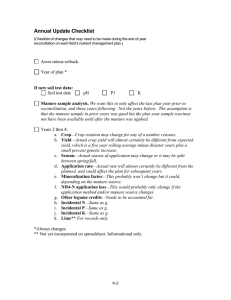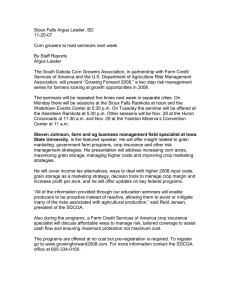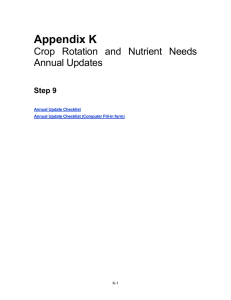Silver Run Farm 1400 West Penn Grant Road Lancaster, Pa. 17603
advertisement

U.S. POULTRY & EGG ASSOCIATION FAMILY FARM ENVIRONMENTAL EXCELLENCE AWARD Silver Run Farm 1400 West Penn Grant Road Lancaster, Pa. 17603 Silver Run Farm · Pennsylvania Environmental Agricultural Conservation Certification of Excellence. July 2002 Inaugural class · Tyson Foods National Environmental Stewardship Award February 2003 · Pennsylvania’s first and only Certified Angus Beef Licensed Feedlot. Since 2000 · Recognized by Pennsylvania’s Governor at the opening ceremonies of the 2005 Pennsylvania Farm Show for 250 years of operation by the Hess family at this location. Karl and Elma Hess on June 12 th 2004 at the worship service held in the barn built in 1862 to celebrate the 250 th anniversary of the original deed for the farm signed by Thomas and Richard Penn. There were some 350 people in attendance Entrance to farm Silver Run Farm is a diverse family operated crop and livestock farm located in Lancaster County, Pennsylvania. The Karl Hess family is pleased to represent the 8 th and 9 th generations of our family to have the privilege to live and work here. The 250 acres of cropland are all operated under an approved conservation plan and all manures are applied according to the guidelines of an approved P­based nutrient management plan. Field crops are corn, soybeans and small grains. These crops are used primarily as feed inputs for the cattle feedlot. Livestock enterprises include a cattle feedlot marketing some 300 head annually. Silver Run Farm as been operating as Pennsylvania’s only feedlot licensed by Certified Angus Beef since 2000. There are less than 5 licensed feedlots east of the Mississippi River. We have custom fed cattle for clients from Vermont to South Carolina and as far west as Ohio. Broiler houses are under contract with Tyson Foods, New Holland. The swine finishing facility is under contract with Carroll Foods, a division of Smithfield, headquartered in Virginia. The swine are fed and managed locally by White Oak Mills of Elizabethtown, Pennsylvania. Karl and Elma have 3 sons and all are pursuing careers in agriculture. Our oldest son Konrad works in a nearby sow unit operated by Hostetter Management and houses some 1400 sows. This is a farrowing unit only and weaner pigs are shipped from this facility weekly. Jonathan is a 2001 graduate of Penn State University with a degree in Animal Bioscience and a minor in Ag Business. Jonathan then worked for Tyson Foods New Holland as a production manager. More recently Jonathan was employed by Star Rock Farms of Conestoga, Pennsylvania, as a feedlot manager overseeing some 2000 head of cattle on feed, primarily using food byproducts in the ration. Jonathan has recently returned to Penn State to peruse a masters degree and anticipates entering the classroom as a high school ag teacher in the fall of 2006. Michael has just begun his undergraduate program at Penn State. He is perusing a degree in Ag education as well with a minor in Ag Communications. Michael has just completed a year of service to the FFA serving the Commonwealth of Pennsylvania as president. This followed serving his local Manor FFA chapter as president his senior year in high school. During this year Michael also served as Lancaster County FFA president. The highlight of Michael’s tenure as state FFA president was undoubtedly June 14 th when he had the privilege of meeting and introducing President. Bush who had agreed to address the state convention as the keynote speaker. Michael also wants to return to the classroom as an ag teacher after graduation. Essay Questions Litter Management Techniques Great effort has been made over the last several years to establish a deep base of 4­6 inches of litter in all broiler houses. Now that that goal has been achieved effort is made now to maintain that minimum depth. Maintaining the desired depth starts with maintenance of the waterers. Fittings and hose connections are checked frequently to assure they do not leak and water is triple filtered before going to the waterers to assure water is clean and the nipple contacts are not compromised with foreign matter that would cause leaking. Pressure regulators are used after the final filtering to make sure we do not exceed manufacturer’s recommendations on pressure to further minimize leaking. As a result of careful litter maintenance during the flock cycles, little cake develops, and minimal amounts of litter must be removed between flocks. This allows the manure to be safely stored in the houses until such time that crop nutrient needs require field applications of manure. Timing of applications are as close to crop uptake as time will allow. The majority of field applications are made during the spring, primarily March and April and manure is usually incorporated lightly into the soil profile with a field cultivator to allow for maximum retention of residue on the surface. These applications will most likely be made to fields that were planted to no­till soybeans the previous year. Given previous manure history and monitoring of residual soil fertility with soil tests every 3 years, and manure testing every 3 years, we have learned that a field application of 2 to 2.5 tons of litter will supply the phosphorous necessary to grow an upcoming corn crop and will also supply sufficient additional phosphorous for the subsequent soybean crop. Corn crops are monitored for actual nitrogen available through actual nitrogen soil testing when the crop is 12 to 18 inches tall and post harvest testing of stalks to help determine if the corn crop had sufficient nitrogen available during the growing season. This becomes a measure of actual nitrogen efficiency. These test results along with application rates and manure and soil test allow one to continually fine tune application rates for maximum crop benefit and minimal environmental impact. This means that field crop acres are usually split about 50/50 between minimum­till corn and no­till soybeans. Light incorporation of the manure reduces the likelihood of additional phosphorous movement into surface water after field application. If adequate residue is maintained on the surface, soil loss is also minimized. Litter is applied with specialized applicators that allow for precise application rates with required tolerances of +/­ 0.3 tons per acre and also has adequate floatation to minimize compaction. Should fall applications be necessary the fields will be planted to a small grain as either a cover crop or a crop to be harvested for feed the following year. All litter is used within the operation. Manure applications based on a nitrogen based nutrient management plan were begun in 1992. Phosphorous based nutrient management plan application rates were begun in 2004. When cleaning out a poultry house only lanes of 7 feet under the 4 water lines are removed. The remaining litter is then leveled before the next flock is started. Also between each flock, used dry wood shavings from a neighboring horse farm are spread in the houses and incorporated into the top several inches of litter. This further enhances our ability to maintain a deep dry litter base in our houses. The dry litter allows us to minimize odors. An unexpected, but much appreciated benefit from the use of deep litter is significantly lower amounts of supplemental heat that must be used. The deep litter appears to have a built in insulating effect as well as some supplemental heat seems to be actually supplied by the litter itself from the life going on in the litter. Placing your hand into the 4 – 6 inches of litter after final grooming and just before lighting the brooders for the next flock, one will notice that there is some warmth that would not be there if one was using new bedding with each flock. An additional improvement planned for the upcoming spring is the use of GPS to provide guidance of application patterns in the fields. This will allow for most applications of litter to occur at night when one has the best chance for calm winds. Benefits to including GPS guidance for litter applications will enhance the ability to apply litter at the desired rate, with minimal over or under applications. Being able to spread in calm winds also minimizes drift of litter dust to off site locations which promotes an improved public perception of the poultry industry. Community Involvement & Environmental Promotion Community involvement started with serving on the planning commission of my local township. I had the privilege of serving for 14 years and the last 8 years I served as chairman. Development pressure is intense in this part of Lancaster County and many opportunities presented themselves to be an advocate for all type of production agriculture, beyond poultry. More recently I have the opportunity to achieve my individual license to write nutrient management plans for our farm. As Pennsylvania began moving from a nitrogen based plan to a phosphorous based plan I was able to have some influence in having the initial draft changed to allow for the applications of manure to include all phosphorous to be taken up by the crops between the time of application. The result of this decision allows for the application of the phosphorous necessary, for example, to grow a crop of corn and the subsequent crop of soybeans the following year at the time of planting the corn crop. The result is more nitrogen can be applied which will more closely meet the total nitrogen requirement of the corn crop. Manure applications in alternate years further minimize compaction and result in improved soil quality. Initial drafts of Pennsylvania’s P based nutrient management regulations would have required only phosphorous applications that would be used by the next crop to be planted. The result would have been to need to supply additional nitrogen to grow a crop of corn and any phosphorous applied via litter for soybeans would have applied additional nitrogen that would not have been needed by the soybean plant. I was pleased that as part of my phosphorous based training I could make this suggestion to those writing the guidelines, resulting in producers within Pennsylvania having a more farmer friendly final document. As I have begun a ‘second’ career as a Farm Service Agency farm loan officer for Lancaster County in May of 2002 I have further had the opportunity to provide additional guidance to many of my loan clients regarding manure applications and purchased fertilizer needs. As I assist our borrowers in financial planning and cash flow projections I began to notice that many of our borrowers were struggling to know how best to interpret their soil test results and make appropriate adjustments to application rates which would account for manure applications. Since well over 100 borrowers had similar type operations, I developed a phosphorous based spread sheet that allows for the input of 4 basic numbers that apply to all these common producers and gives them a resulting $$$dollar amount as to what their fertilizer bill for the year should be. The majority of these farms are small Amish dairies with 35 – 60 cows and cropping from 30 – 60 acres. Crop acres are usually split between corn for silage, corn for grain and alfalfa for hay. The program allows for a one time input of unit prices for nitrogen, phosphorous and potash each year. It also assumes reasonable yield projections of 5 year county averages. The producer then supplies our office with the number of cows; the number of acres for corn, corn silage and alfalfa and the program gives them a net cost their operation should most likely need to spend for purchased fertilizer for the upcoming year. Producers use their soil test results to determine what types of fertilizer they need and the fields that need attention, the dollar amount supplied by our FSA office helps them not over spend for fertilizer. This tool has allowed numerous borrowers to reduce their purchased fertilizer needs by up to 100%. This results yield both environmental and financial benefits. While the benefits of this tool directly benefit dairy farmers in Lancaster County, preventing additional burdensome regulations that result from continued over application of commercial fertilizer benefit all of agriculture including poultry. Conservation & Wildlife Enhancement Our home farm has a stream that flows through the property. The banks of the stream are maintained in grasses to promote wildlife habitat. Slopes are gently sloped, and trees are controlled to allow the grasses to maintain a vigorous stand to stabilize the stream bank and prevent erosion from adjoining cropland. The stream serves as the receiver of numerous underground draining pipes that discharge into it. Outlets for storm water from pipe outlet terraces in the fields are conveyed underground to the stream. All buildings are spouted and the roof water, when not collected in cisterns, is conveyed to the stream underground to further control erosion . Clean storm water from driveways are also controlled and after entering a sediment basin is discharged underground to the stream. The stream has been the study of the biology department at Millersville University for over 5 years and results have been presented at scientific meetings as well as published in scientific journals. The overall results of this study is that the water quality of the stream in the pond immediately downstream from our farm is of higher quality than the water of the pond that discharges onto our farm. The result of careful monitoring of timing and rates of manure applications over the years has resulted in a very low loss of nutrients into the stream. We are thankful that we can operate our farm with a high concentration of livestock with minimal impact on the water quality of the stream that traverses our farm. Water quality as also been enhanced over the years by the incorporation of many BMPs through cost sharing provided by the Chesapeake Bay Program and EQUIP funds administrated by the Natural Resources Conservation Service. The total approach to growing field crops was changed from the practices used by previous generations. These funds allowed for the installation of over 6,000 feet of pipe outlet cropland terraces as well as numerous other conservation practices including waterways, stormwater management structures and underground piping to allow for the conveyance of roof water to the near by stream. Field crops are now all planted on the contour. Cropland terraces and contour farming applies to rented ground and not just to land owned by our family. Manure storages totaling over 400,000 gallons have been constructed to store manures produced by species other than poultry. Cattle feedlots have had roofs added over them, and walls built around them to further reduce the possibility of runoff from these parts of our operation. Living at the rural urban interface of agricultural and residential land uses presents additional challenges. As some 30 plus single family homes have been built adjoining our farm over the last 25 years I have learned that in addition to water quality, my neighbors are also very concerned with water quantity, as all are served by on lot water. Some have had to drill several sites to achieve a well they can use, and many have limited flow. While we are seemingly blessed with very adequate water from the original hand dug well established some 170 years ago, I did not want to be insensitive to the concerns of my neighbors. To address their concerns about the amount of water I would be removing from the groundwater we have installed spouting on most of our new livestock buildings. The water is collected and piped into two underground storage tanks with total storage capacity of 28,000 gallons. It takes less than 2 inches of rainfall to fill these tanks. The water is then consumed by the livestock, primarily the swine and the poultry. It serves as a backup to supply additional water, especially in times of high temperatures and the need to mist the chickens. Over a years time this system collects in excess of the total amount of water consumed by one of my two broiler houses. In addition to having ‘extra’ water available the spouting and collecting of the roof water also makes it easier manage stormwater, as with the roof water controlled, the amount of stormwater is greatly reduced. To further manage storm water and improve water recharge a large infiltration bed was established between the 2 broiler houses. This allows significant amounts of storm water to infiltrate the ground water and increase recharge for all wells in the area. Innovations Mortality is handled by composting. Composting of all mortality is handled in a composter with 4 small bins and 1 large bin to handle larger animals as necessary. Our farm has poultry, swine and cattle on feed. Small bins that would be satisfactory for poultry may not be of sufficient size for mortality from the swine and cattle operations. There is a turning bin as well, where after an initial period of composting; a bin can be turned to complete the process, before field application of the compost. The extra bins serve as storage for additional litter as a necessary to cover the compost. Many times the pen pack stable manure from the cattle pens can be used to cover the mortality. The straw or corn fodder in the bedding supplies the carbon to aid in the composting process. As previously mentioned our operation also involves cattle and swine. The manure from both the cattle and swine are stored together as liquid in a 400,000 gallon glass lined storage. The bedding from the cattle allows the swine manure to be stored with a thick crust on top of the storage, which further reduces odors from the swine manure while in storage. The location of the storage is central to significant portions of tillable land and the manure can be field applied using a drag line and a spreader bar. This allows the manure be applied at a rate approaching 100,000 gallons per hour and with little or no compaction that would traditionally be part of field applications using tractors and tankers or trucks to haul and spread the manure. Application rates of this liquid manure can also be more precisely controlled through the monitoring of the actual gallons applied by a flowmeter and the actual acreage covered, all recorded and monitored in the tractor pulling the spreader bar. The reduced compaction results in less need to do tillage and with light incorporation and the use of a no­till corn plante,r a crop can be planted. The end result is nutrients from manure remain where they were placed and high residue minimum­till and no­till planting further reduces soil loss from erosion as well as aiding in the conservation of water resources to produce the next years crop. When we were deciding about entering the poultry production business in 1997, placement of the poultry houses was an issue that occupied a lot of our time. We were able to place the houses in such a way that they naturally fit into the contours already established for the farm. To achieve good efficiency we felt placing the houses relatively close to the public road was a good idea. To further enhance their location we planted an evergreen buffer of trees adjacent to the road to provide natural screening. We also designed the houses so that no ventilation fans faced the road. This limited the dust and odors that would possibly be noticed by the traveling public. The tunnel fans that would be used during the warmer months of June through September would have natural buffers supplied by the corn and soybean crops planted each spring. The sidewall ventilation fans are on the side of the house not visible from the road. The result is a pleasant looking building that is visible to the traveling public. Environmental Management Training Having undergraduate degrees in both chemistry and biology have given me a good start in understanding the complexities of ecology and ecosystems as well as the nuts and bolts of the why’s and how’s of many of the chemical process that occur in normal farm life. Over the years this knowledge base has aided in helping make good choices in livestock feeding rations. Having adequate, but not excess minerals available for acceptable livestock performance has aided in reducing the nutrient load of many of the manures produced on the farm. More recently as environmental awareness increased, I took advantage of all the educational opportunities available to learn about the proposed nutrient management laws being considered in Pennsylvania. This ultimately resulted in my being certified to write nutrient management plans for our own operation. This certification initially applied to nitrogen based plans, but eventually lead to my participating in all additional classes necessary to receive my license to write phosphorous based plans, including the use of the P index here in Pennsylvania. Environmental Responsibility Environmental stewardship means trying your best to always do the right thing. Environmental stewardship starts with a basic understanding, when it comes to the land, and how we care for it, that we are indeed stewards. A steward is one who cares for another’s property or possessions. As one who is involved in production agriculture, I clearly understand that I own nothing, but am the steward of something that was created by someone else and that I will ultimately, one day be accountable to that Creator for how I conducted myself while I was entrusted with the care of His property. My basic premise of operation, for the years I have been farming, has always been to seek to honor God in all that I do. That includes my stewardship responsibilities of the environment as well as how I conduct my business affairs. I also clearly understand that I have benefited greatly from the efforts of previous generations who cared for this place. Though by today’s standards, one would say that they could have done better; I believe that they sincerely believed they were doing their best. I hope the next generation will find that during my tenure as ‘chief steward’ I was faithful in carrying out my mission, and left the farm in better condition than when I began. Environmental stewardship means doing what is right when no one else but you and God would know any difference. I seek to do the right thing even if local, state, or federal government may not have a regulation about a specific practice. Let me share two examples. The first area involves herbicide selection and application. Since we have had over 37 different single­family homes built over the last 20 years adjoining our cropland, I always seek to find the lowest residual and least toxic combination of herbicides and insecticides practical for these borders. I am even willing to apply different tank mix of materials on land adjacent to residential boundaries, to minimize the risk to anyone from these residences who may ‘accidentally’ walk through our fields to pesticide exposure. The second is my desire to learn all I can about the problems associated with excess phosphorous in the environment and things I can do now to decrease my contribution to the problem. This is why I have obtained by certification upgrade to write P­based nutrient management plans, and why I am planning on obtaining GPS guidance equipment to further assist in more precise field applications of my poultry manure. None of the above mentioned practices are required by any governing agency. Going the extra mile, however, is always a good practice in demonstrating one’s desire to exercise environmental stewardship.



